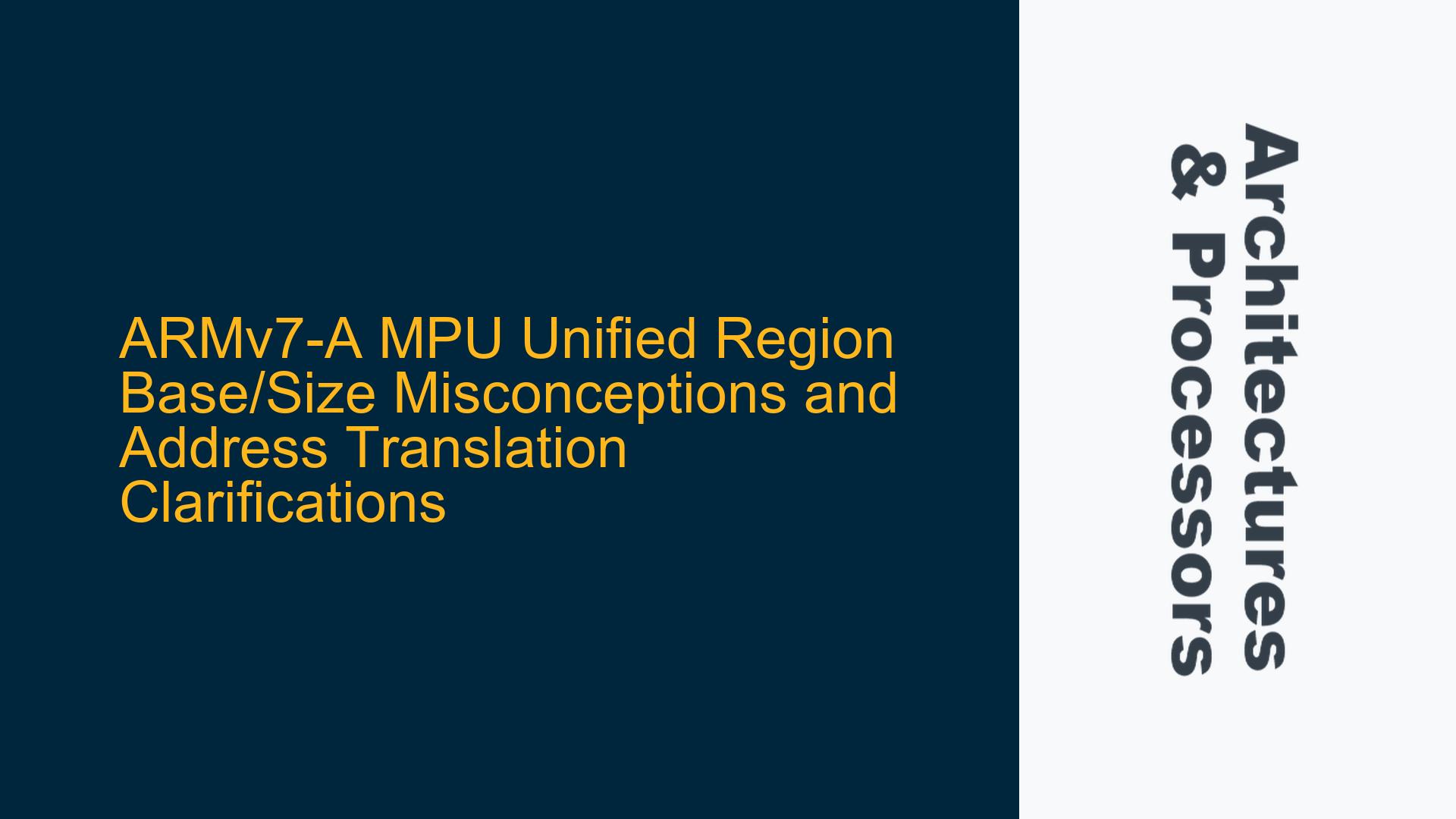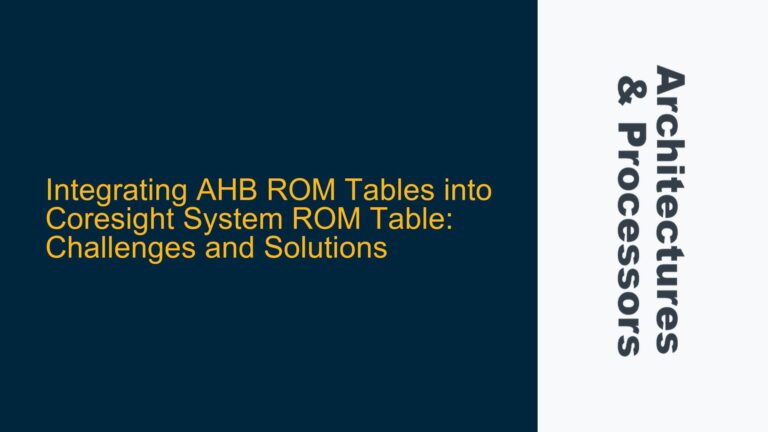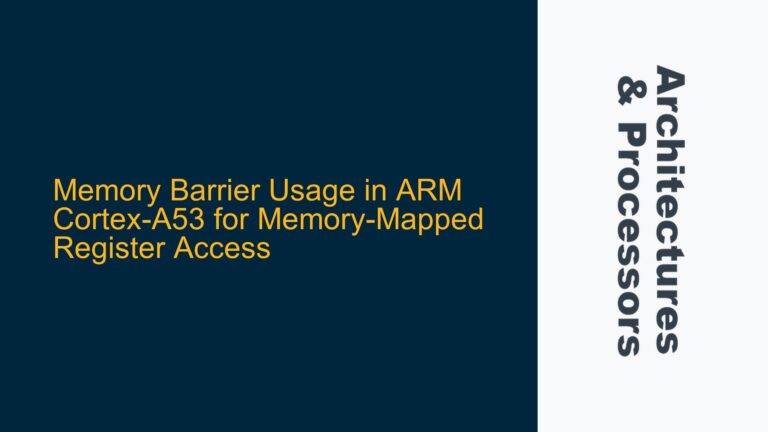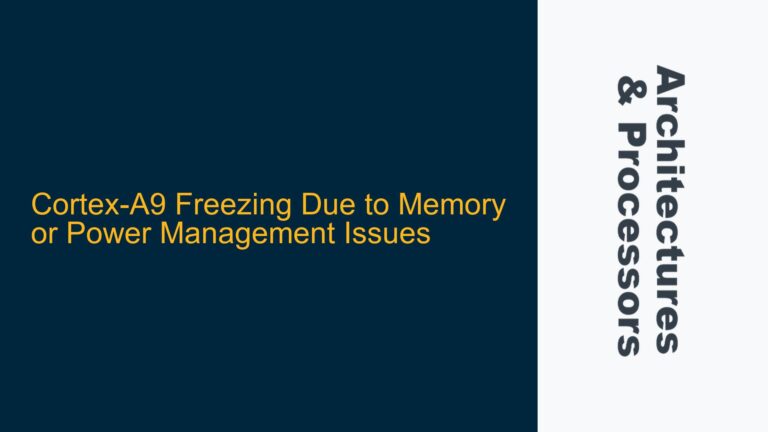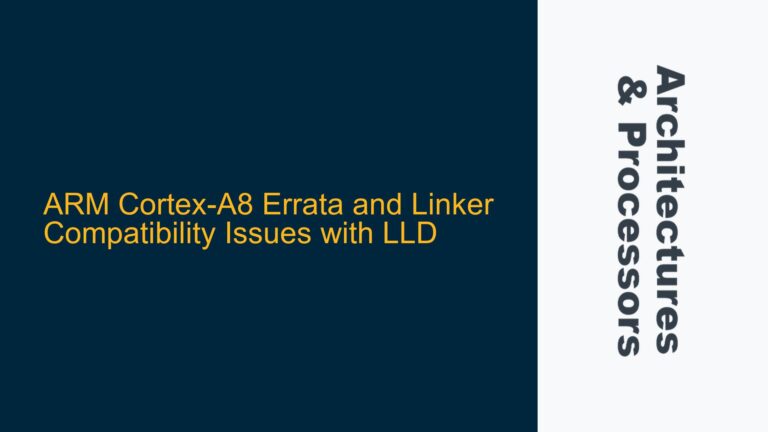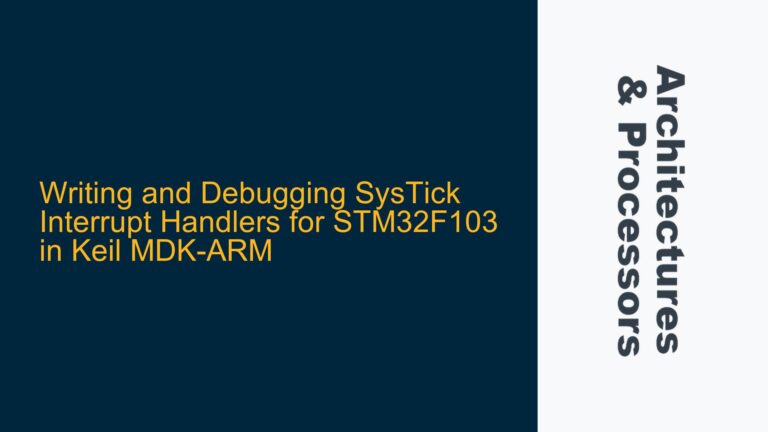ARMv7-A MPU Unified Region Base Address Misinterpretation
The ARMv7-A architecture, widely used in embedded systems, incorporates a Memory Protection Unit (MPU) designed to enforce memory access permissions and enhance system security. A common misconception arises regarding the functionality of the Unified Region Base and Size registers within the MPU. Specifically, developers often assume that the Base address value specified in the MPU configuration is added to memory references, effectively acting as an offset or translation mechanism. This assumption is incorrect and can lead to significant misunderstandings in system design, particularly when attempting to implement memory protection or address translation without the use of paging.
The MPU in ARMv7-A is primarily a protection mechanism, not an address translation unit. The Base address defines the starting point of a memory region, and the Size register determines the extent of that region. These registers work together to define a protected memory area, but they do not modify the addresses generated by the processor. This distinction is crucial for developers aiming to implement memory protection schemes or enforce access restrictions in systems where paging is not utilized.
MPU Base Address Functionality and Cortex-R Comparison
The confusion surrounding the MPU’s Base address functionality is compounded by differences between ARM architectures. While ARMv7-A processors typically do not include an MPU (with the exception of certain Cortex-R series processors), the Cortex-R series does feature an MPU. However, even in Cortex-R processors, the MPU’s Base address does not act as an offset or translation mechanism. Instead, it serves as the starting address of a memory region that the MPU will monitor and protect.
In ARMv7-A, the MPU’s primary role is to enforce access permissions and attributes for defined memory regions. The Base and Size registers are used to specify the boundaries of these regions, but they do not alter the addresses generated by the processor. This means that if a processor generates an address, the MPU will check whether that address falls within any of the defined regions and apply the corresponding access permissions. The MPU does not add the Base address to the generated address, nor does it perform any form of address translation.
This behavior is consistent across ARM architectures that include an MPU, including the Cortex-R series. The MPU is designed to protect memory regions, not to modify addresses. This is a critical distinction that developers must understand when designing systems that rely on the MPU for memory protection.
Implementing Memory Protection Without Address Translation
Given that the MPU does not perform address translation, developers seeking to implement memory protection without paging must adopt alternative strategies. One common approach is to use the MPU in conjunction with carefully designed memory maps and access control mechanisms. By defining memory regions that correspond to specific system components or functions, developers can enforce access restrictions and protect critical system resources.
For example, consider a system where certain peripherals or memory-mapped I/O devices need to be protected from unauthorized access. The developer can define MPU regions that encompass these devices and set the appropriate access permissions. When the processor generates an address that falls within one of these regions, the MPU will enforce the specified permissions, preventing unauthorized access.
Another approach is to use the MPU in combination with software-based address translation. While the MPU itself does not perform address translation, software can be used to map virtual addresses to physical addresses before the MPU checks the access permissions. This approach requires careful coordination between the software and the MPU configuration, but it can provide a flexible and powerful mechanism for memory protection.
In systems where paging is not an option, developers must rely on the MPU’s ability to define and protect memory regions. By understanding the MPU’s limitations and capabilities, developers can design systems that effectively enforce memory protection without relying on address translation. This requires a thorough understanding of the MPU’s configuration registers, including the Base and Size registers, and how they interact with the processor’s memory access mechanisms.
Detailed Analysis of MPU Configuration Registers
To fully grasp the functionality of the MPU in ARMv7-A, it is essential to delve into the details of its configuration registers. The MPU typically includes several registers that control its operation, including the Unified Region Base and Size registers. These registers are used to define the memory regions that the MPU will protect.
The Unified Region Base register specifies the starting address of a memory region. This address must be aligned to the size of the region, as specified by the Size register. The Size register defines the extent of the memory region, typically in powers of two. For example, a Size value of 0b1000 might correspond to a region size of 64 KB.
When the MPU is enabled, it will monitor all memory accesses and check whether they fall within any of the defined regions. If an access falls within a protected region, the MPU will enforce the access permissions specified for that region. These permissions can include read, write, and execute permissions, as well as other attributes such as cacheability and shareability.
It is important to note that the MPU does not modify the addresses generated by the processor. The Base address specified in the Unified Region Base register is not added to the generated address. Instead, it serves as the starting point for the memory region that the MPU will protect. This means that the MPU’s role is purely protective; it does not perform any form of address translation or modification.
Practical Considerations for MPU Configuration
When configuring the MPU in an ARMv7-A system, several practical considerations must be taken into account. First, the alignment of the Base address is critical. The Base address must be aligned to the size of the region, as specified by the Size register. Failure to align the Base address correctly can result in undefined behavior or system faults.
Second, the size of the memory region must be carefully chosen. The Size register typically allows for region sizes that are powers of two, ranging from a few bytes to several megabytes. Choosing an appropriate region size is essential for effective memory protection. Regions that are too large may encompass areas of memory that do not require protection, while regions that are too small may leave critical areas unprotected.
Third, the access permissions and attributes specified for each region must be carefully considered. The MPU allows for fine-grained control over memory access, including read, write, and execute permissions. Additionally, attributes such as cacheability and shareability can be specified for each region. These attributes can have a significant impact on system performance and behavior, so they must be chosen with care.
Finally, the interaction between the MPU and other system components must be considered. For example, if the system includes a cache, the MPU’s cacheability attributes must be configured to ensure that the cache operates correctly. Similarly, if the system includes multiple processors or cores, the MPU’s shareability attributes must be configured to ensure proper synchronization and coherency.
Addressing Common Misconceptions and Pitfalls
One of the most common misconceptions about the MPU in ARMv7-A is that it performs address translation. As discussed earlier, this is not the case. The MPU is a protection mechanism, not a translation mechanism. Developers must understand this distinction to avoid designing systems that rely on the MPU for address translation.
Another common pitfall is the misalignment of the Base address. As mentioned earlier, the Base address must be aligned to the size of the region. Failure to align the Base address correctly can result in undefined behavior or system faults. Developers must ensure that the Base address is correctly aligned when configuring the MPU.
A third common pitfall is the improper configuration of access permissions and attributes. The MPU allows for fine-grained control over memory access, but this control must be used wisely. Improperly configured access permissions can result in system faults or security vulnerabilities. Similarly, improperly configured attributes can result in performance degradation or incorrect system behavior.
To avoid these pitfalls, developers must thoroughly understand the MPU’s configuration registers and how they interact with the processor’s memory access mechanisms. Careful planning and testing are essential to ensure that the MPU is configured correctly and that the system operates as intended.
Conclusion
The ARMv7-A MPU is a powerful tool for enforcing memory protection in embedded systems. However, its functionality is often misunderstood, particularly regarding the role of the Unified Region Base and Size registers. These registers define the boundaries of memory regions that the MPU will protect, but they do not modify the addresses generated by the processor. Developers must understand this distinction to effectively use the MPU for memory protection.
By carefully configuring the MPU’s Base and Size registers, as well as the associated access permissions and attributes, developers can create systems that enforce memory protection without relying on address translation. This requires a thorough understanding of the MPU’s capabilities and limitations, as well as careful planning and testing. With the right approach, the MPU can be a valuable tool for enhancing the security and reliability of ARMv7-A-based systems.
